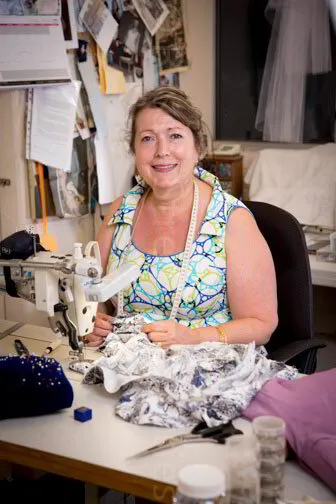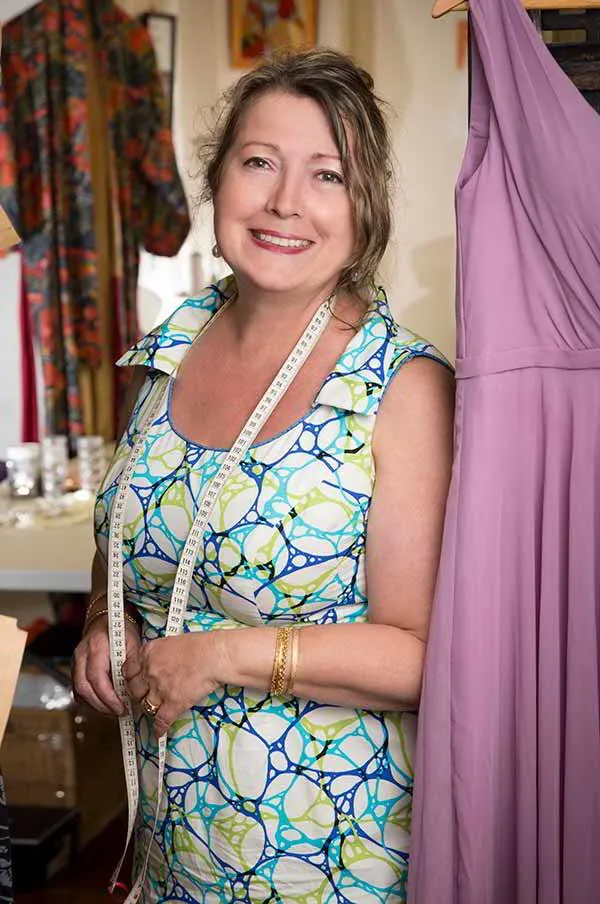Vintage Wedding Dresses: A Timeless Bridal Choice for Your Special Day. Shop Vintage!
As a Brisbane Dressmaker, I have seen that Vintage Wedding Dresses have become a popular choice for brides seeking a unique and timeless look for their special day.
These wedding gowns not only embody the elegance and charm of bygone eras but also offer a story and heritage that modern gowns can seldom match. You will find gowns made of beautiful vintage lace, satin and silk in beautiful ivory colours, and wedding gowns that are often decorated with tulle, intricate beading.
In my comprehensive guide, I will dive into the world of vintage wedding dresses, exploring their appeal, varieties, and how to choose the perfect one for your wedding. I'll also share my experience and knowledge in fabrics, embellishments, and how I can potentially help you with a vintage wedding dress alteration.
Why Choose a Vintage Wedding Dress?
A beautiful and unique garment
Preserve history and craftsmanship of the dress
Honor the previous owner of the gown
A smart, sustainable choice for the environment
Opting for a vintage wedding dress is like wearing a piece of history.
Every vintage wedding dress is a treasure trove of stories, an emblem of timeless elegance and personal history. These gowns are not just fabrics and threads; they are the keepers of memories, each stitch a reminder of a cherished past.
At Aiga's Sewing Services, we understand that your vintage wedding dress is more than an attire—it's a precious heirloom that deserves the utmost care and skilled craftsmanship. Entrust us with your gown, and let's honor its unique story together, ensuring it's as perfect as your special day.
Choosing a vintage wedding dress also champions sustainability, making a positive impact on the environment. By recycling a piece of history, you're reducing the demand for new garments and the resources they consume. This choice not only celebrates the craftsmanship of the past but also contributes to a more sustainable future, reducing waste and promoting the reuse of precious materials. Embracing a vintage gown is a beautiful way to express your commitment to environmental stewardship while enjoying the unique charm and story of your wedding dress.
Vintage Wedding Dress Alterations by Aiga
Finding Your Perfect Vintage Wedding Dress
Selecting a vintage wedding dress is a journey that marries the elegance of the past with the fit and condition considerations of the present.
Understanding the styles of different eras helps in choosing a dress that reflects your personal taste and wedding theme. It's crucial to examine the dress's condition, considering repairs or cleaning needs, and to ensure alterations preserve its vintage integrity.
Finding the right gown may lead you through bridal boutiques, online shops, and thrift stores, each offering unique treasures. This guide aims to simplify the process, ensuring you find a vintage wedding dress that captures timeless beauty and fits perfectly.
Know Your Vintage
Understanding the distinct styles and characteristics of different eras can help you decide which vintage wedding dress resonates with your personal style and the theme of your wedding.
Condition is of the Vintage Wedding Dress is Key
When selecting a vintage wedding dress, pay close attention to its condition. Look for any signs of wear, stains, or damage, and consider whether these are repairable, can be cleaned or updated, or if they add to the dress's character.
Tailoring to Fit
Vintage wedding dresses may require alterations to achieve a perfect fit. You will need to find a skilled dressmaker that is familiar with vintage fabrics and styles. This is crucial to preserving the dress's integrity while tailoring it to your fit your body.
Where to find Vintage Wedding Dresses
Look high and low in a variety of places, from specialized vintage bridal boutiques and online marketplaces to thrift stores and estate sales. Each source offers a unique selection, with the potential to find a one-of-a-kind gown.
Explore the fabrics, vintage lace and other materials found in vintage bridal gowns
Silk
Silk has long been a favored fabric for wedding dresses, prized for its luxurious feel, natural sheen, and excellent drape. It comes in various weaves, including satin, charmeuse, and shantung, each offering a different texture and level of shine. Silk's versatility made it suitable for both elaborate gowns of the Victorian era and the sleek, sophisticated styles of the 1930s and beyond.
Lace
Lace is synonymous with bridal wear, adding delicacy, depth, and detail to vintage wedding dresses. Different types of lace, such as Chantilly, Alençon, and Venise, were popular in various eras, used for full gowns, overlays, sleeves, and accents. Lace's intricate patterns and sheer quality lend a romantic, ethereal quality to wedding dresses.
Tulle
Tulle is a lightweight, net-like fabric often used in vintage wedding dresses for veils and the voluminous skirts of the 1950s and beyond. Its airy structure allows for dramatic volume without significant weight, creating a fairy-tale appearance that has captivated brides for decades.
Satin
Satin, known for its smooth, glossy surface, has been a popular choice for wedding dresses, particularly in the 1930s, 1940s, and again in the 1980s and 1990s. Its reflective quality captures light beautifully, making it a favorite for evening weddings or brides seeking a glamorous look.
Chiffon
Chiffon is a lightweight, sheer fabric with a slight stretch, often used for flowing wedding dress styles, particularly in the 1960s and 1970s. Its transparency and weightlessness make it ideal for layered gowns, offering a soft, ethereal silhouette.
Organza
Organza is a stiff, sheer fabric, similar to tulle but with a smoother texture. It's often used for skirts, sleeves, and overlays, adding structure and volume without heaviness. Organza can create a subtle sheen, adding dimension and interest to the wedding dress
Velvet
Velvet, with its luxurious texture and deep, rich colors, was a popular choice for winter weddings and evening gowns, particularly in the Victorian era and the 1920s. It adds a touch of opulence and warmth, making it ideal for cooler weather or formal settings.
Brocade and Damask
Brocade and damask are rich, textured fabrics featuring woven patterns that often include floral or ornamental designs. Popular in earlier centuries for their luxurious appearance and intricate detail, these fabrics were used for more formal, traditional wedding dresses.
Crepe
Crepe is a soft, crinkled fabric that drapes beautifully, making it a popular choice for wedding dresses in the 1930s and 1940s. Its matte finish offers a sophisticated alternative to the shine of satin or silk, ideal for understated elegance.
Embellishments found on Vintage Wedding Gowns
Lace Detailing
Lace is a hallmark of vintage wedding dresses, offering a timeless appeal that is both delicate and sophisticated. From intricate Chantilly lace to the more structured Alencon lace, these details can be found adorning sleeves, bodices, and hemlines, adding depth and texture to the gown.
Beading and Sequins
Beadwork and sequins are often used to add sparkle and glamour to vintage wedding dresses, particularly those from the 1920s and 1930s. Hand-sewn beads and sequins create intricate patterns and motifs, catching the light beautifully and making the bride shine on her special day.
Pearls
Pearls are another classic embellishment that lends a vintage wedding dress an air of elegance and sophistication. They can be used sparingly for a subtle shimmer or more extensively to create intricate patterns and designs, often complementing lace and other details.
Embroidery
Embroidery in silk or cotton thread is a common feature in vintage wedding dresses, adding color and dimension. Floral motifs are particularly popular, offering a romantic and feminine touch that enhances the dress's overall beauty.
Appliqués
Appliqués, often in the form of lace or fabric cut-outs, are sewn onto the dress to add texture and interest. These can be floral designs, geometric shapes, or any number of patterns, carefully placed to flatter the bride's figure and add to the dress's visual appeal.
Ribbons and Bows
Ribbons and bows add a sweet, romantic touch to vintage wedding dresses, often used to cinch the waist or as decorative elements on the dress's back or shoulders. Satin and velvet ribbons are particularly popular, offering a contrast in texture and a nod to the feminine styles of past eras.
Illusion Necklines
Though not an embellishment in the traditional sense, illusion necklines created with sheer fabric like tulle or lace add a subtle allure and sophistication to vintage wedding dresses. They allow for more intricate designs and a play of opacity that can make lace and beadwork stand out even more.
Ruffles & Frills
Ruffles and frills were popular in various eras, particularly the Victorian era and the 1980s, adding volume and a dramatic flair to wedding dresses. They can be found on skirts, sleeves, and necklines, contributing to the unique silhouette and style of the gown.
Buttons
Decorative buttons, often covered in fabric or featuring intricate designs, serve both a functional and aesthetic purpose on vintage wedding dresses. They are commonly found on the back of the gown, trailing down the bodice or skirt, adding a classic touch to the overall design.
Introducing Aiga's expertise in alterations specifically for vintage style gowns
Aiga Geddes is a maestro in the art of vintage gown alterations. With over three decades of refined expertise, Aiga brings a deep understanding and a meticulous touch to every heirloom fabric and delicate lace. Her hands are skilled in the delicate task of preserving the essence of each vintage dress while ensuring a flawless fit tailored to your contemporary style. Trust in Aiga's mastery to transform and honour your vintage treasure, making your bridal vision a reality
I love being able to bring women’s ideas to life for their special day. Every woman deserves to feel confident, beautiful and glamorous when they say "I do". Let me bring your vision to life and turn your wedding gown into one that looks and fits you perfectly.
I’m located in Brisbane and available Monday to Saturday by appointment only. I offer a free 15-minute consultation to discuss whether I’m able to alter your vintage wedding dress.
Why Choose Aiga for Your Vintage Dress Alterations?
With over three decades of dedicated craftsmanship, Aiga Geddes stands as a distinguished figure in the realm of formal and wedding dress alterations. Specialising in the intricate realm of vintage wedding dresses, Aiga's expertise extends beyond mere alterations. She excels in meticulously tailoring each gown to the unique contours and style of its wearer, ensuring a fit that's nothing short of perfection. Aiga's hands have skillfully transformed countless bridal visions into reality, from modern online purchases to treasured family heirlooms, ensuring every dress tells its own exquisite story on your special day.
FAQ's about alterations for Vintage Wedding Garments
Can a vintage wedding dress be altered?
Yes, a vintage wedding dress can often be altered to fit your body perfectly, but it's crucial to approach the process with care and expertise. A qualified dressmaker or tailor, especially one with experience in vintage fabrics and styles, can assess the dress's structure, fabric, and detailing to determine the best approach for alterations. They can transform a vintage garment into a stunning creation that fits you like a glove while preserving its unique character and historical integrity. A qualified dressmaker can transform a vintage garment into a stunning creation.
Aiga can also advise if a garment is the wrong size – too small or the wrong material to be altered.
How much does it cost to transform an old wedding dress?
The cost of major alterations for a vintage wedding dress typically ranges from $880 to $1700 and up. However, it's important to consider the fabric and the intricate nature of altering vintage fabric. These factors can vary significantly, potentially requiring more time and, consequently, increasing the overall cost of any alterations.
How much does it cost to adjust a wedding dress?
If you find a wedding dress you absolutely adore but it requires alterations, whether minor adjustments or a major remodel, the cost will depend on several factors. These include the time needed for the alterations, and whether additional materials are required, such as extra fabric, beading, or replacing an old metal zipper with a new invisible one. Other factors that can affect the cost are the need to add and source vintage lace motifs or fabrics to enhance the dress, creating loops and lace-up details for the back of the dress (with or without a modesty panel), crafting covered buttons, or designing a matching belt. Each of these elements contributes to the overall cost, reflecting the complexity and materials of the alteration.
How old does a vintage wedding dress have to be?
The dress, being at least 20 years old, will have drawn inspiration from specific eras: the 1920s, 1950s, and 1970s. The gown will often embody a distinct style and elegance, complemented by matching accessories such as tiaras, veils, hats, fascinators, gloves, and hoops.
Can you get the yellow out of a vintage wedding dress?
Unfortunately, restoring the original color of a vintage wedding dress that has yellowed is almost impossible. The fabric's condition is crucial, and there's a high risk of damage. Professional assessment is necessary to determine if restoration is feasible.
How do you wash a 60 year old wedding dress?
When cleaning vintage dresses, the fabric's condition is of the utmost importance, and professional assistance is often required from a professional dry cleaner who understands how to identify and manage the fabric cleaning (if possible). Options for cleaning vintage fabrics include dry cleaning, spot cleaning with a gentle detergent, or hand washing. However, it's important to be cautious, as even water can cause staining.
Vintage Bridal Dresses are stunning and unique
Altering a vintage wedding dress is a journey that can breathe new life into a timeless piece, making it uniquely yours while honoring its history. With the right professional help, even dresses that seem too small, too large, or made from challenging materials can be carefully and beautifully adapted. Remember, the goal is to enhance the dress to fit you perfectly, ensuring that its vintage charm and character shine through on your special day.



